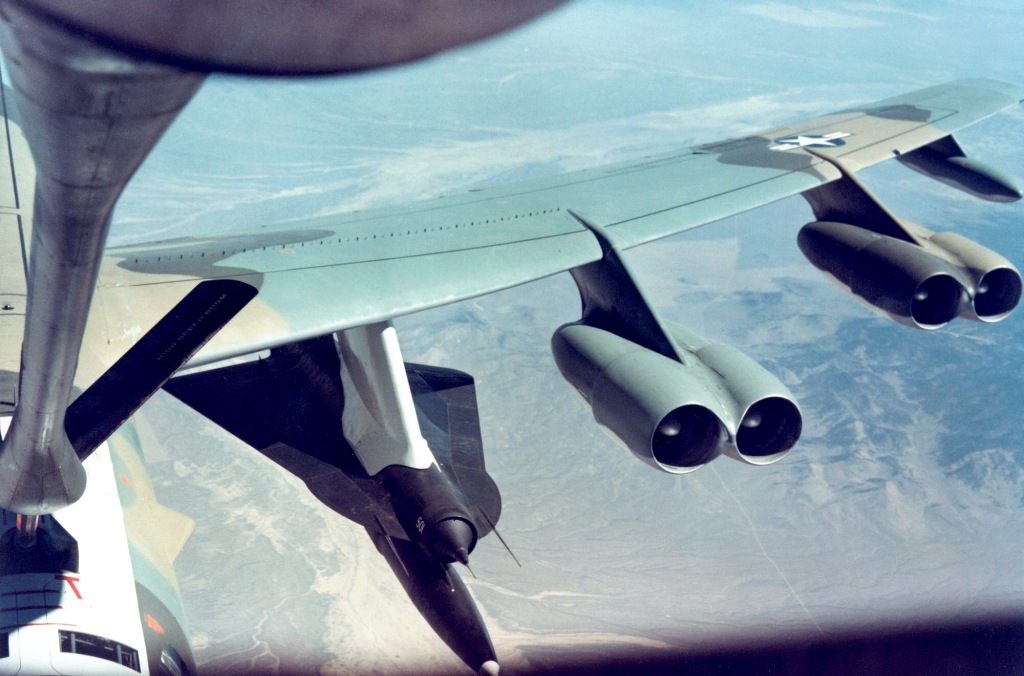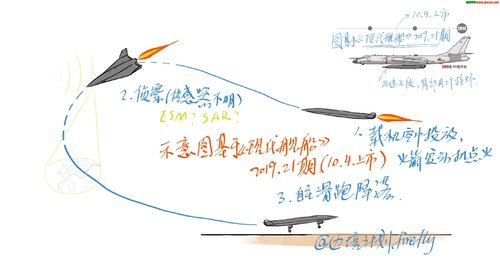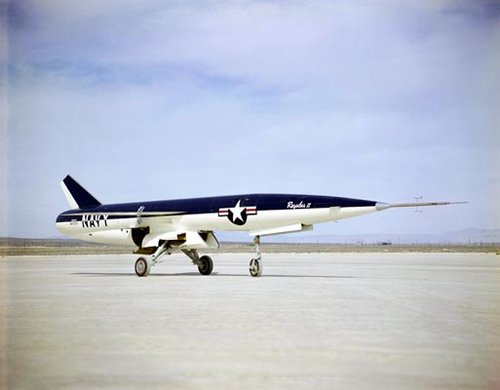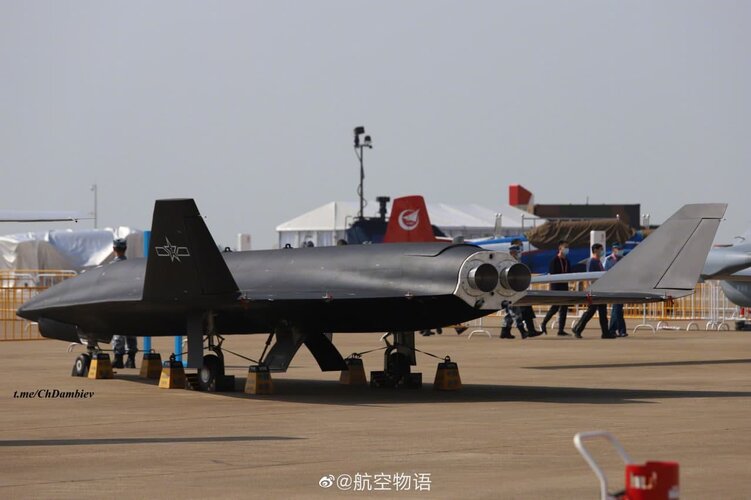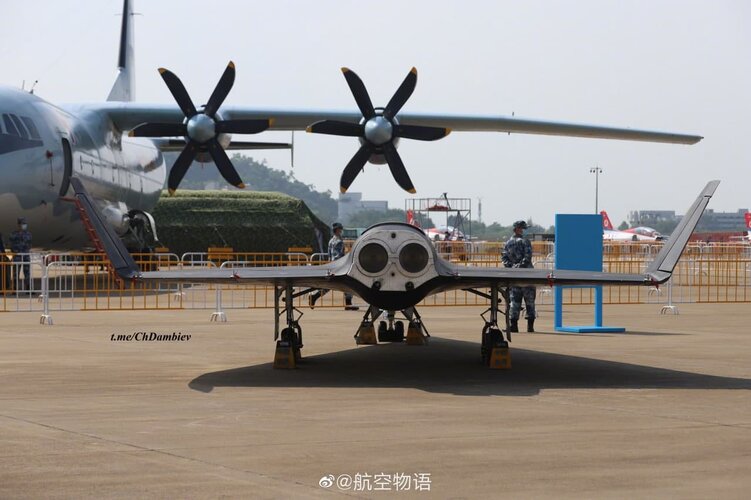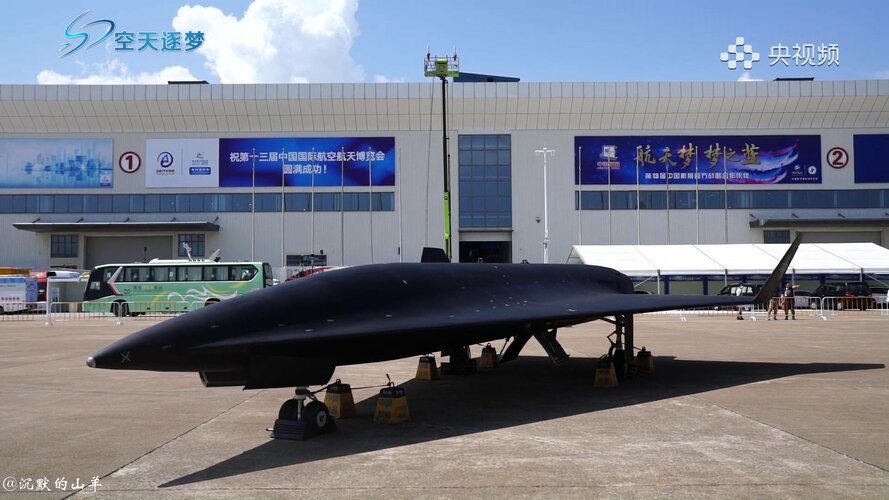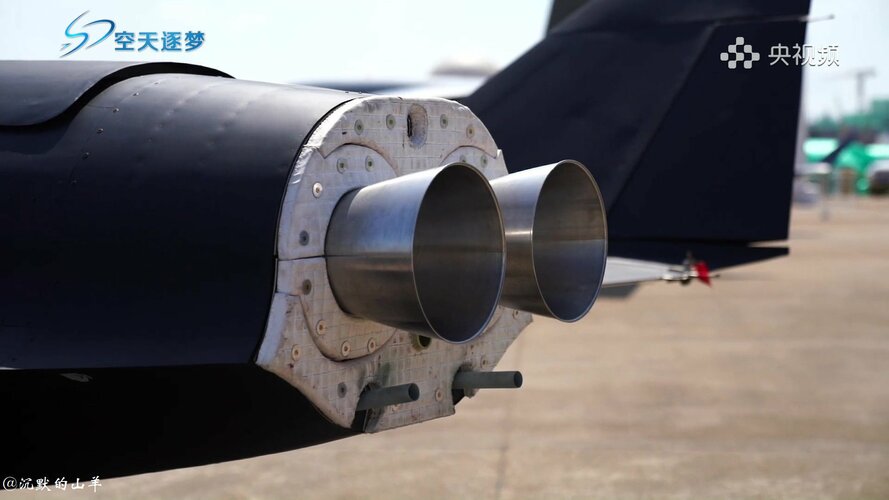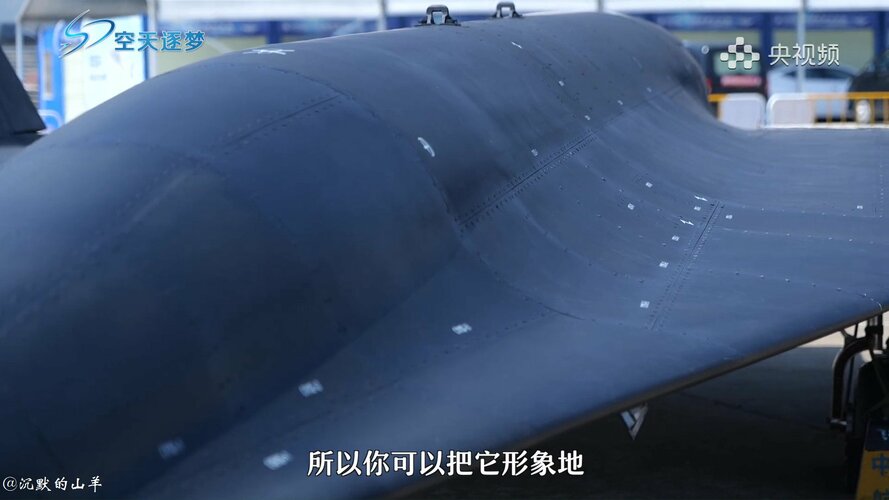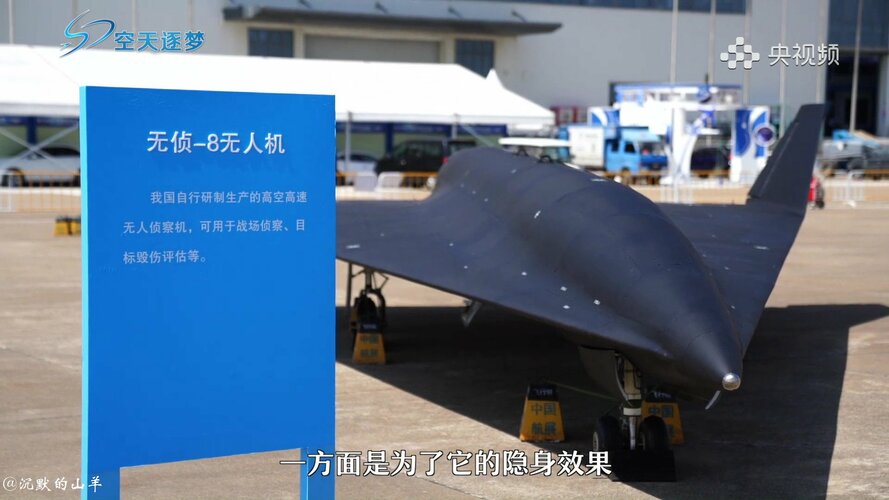You are using an out of date browser. It may not display this or other websites correctly.
You should upgrade or use an alternative browser.
You should upgrade or use an alternative browser.
WZ-8 Supersonic Reconnaissance UAV
- Thread starter FighterJock
- Start date
- Joined
- 4 July 2010
- Messages
- 2,515
- Reaction score
- 3,094
Valid. My point was, the lugs weren't non-flight hardware left attached as an afterthought. One should assume they'll still be in place in flight when attempting to estimate the aircraft's capabilities.China was putting their best foot forward to impress everyone. If those lugs could be unscrewed in 5 minutes, they would have been.
Unless the message they wanted to send was, "we're launching these from a plane".
Lugs are probably sockets that goes on top of the flight worthy ones in order to fit the size of standards handling hardware. That way no pins to secure or dedicated hardware that have to be flown on site.
Last edited:
I think that launching drones from a plane is a bad idea, look at what happened to the M21-D21 when the USAF tried to launch the D-21 from the mothership it crashed causing the death's of the two crew members.
That was because the launch was at supersonic speed from the back of the M-21, and interaction with the carrier aircraft's shock waves caused the D-21 to descend back down onto the M-21. China doesn't have a supersonic aircraft capable of carrying a payload this big, it'll be dropped very conventionally from the belly of a subsonic H-6, so the risk is pretty moderate.
FighterJock
ACCESS: Above Top Secret
- Joined
- 29 October 2007
- Messages
- 5,609
- Reaction score
- 5,938
I think that launching drones from a plane is a bad idea, look at what happened to the M21-D21 when the USAF tried to launch the D-21 from the mothership it crashed causing the death's of the two crew members.
That was because the launch was at supersonic speed from the back of the M-21, and interaction with the carrier aircraft's shock waves caused the D-21 to descend back down onto the M-21. China doesn't have a supersonic aircraft capable of carrying a payload this big, it'll be dropped very conventionally from the belly of a subsonic H-6, so the risk is pretty moderate.
Thanks Trident, a converted H-6 bomber would make a good launching platform for the WZ-8.
- Joined
- 3 June 2011
- Messages
- 18,338
- Reaction score
- 12,240
I think that launching drones from a plane is a bad idea, look at what happened to the M21-D21 when the USAF tried to launch the D-21 from the mothership it crashed causing the death's of the two crew members.
That was because the launch was at supersonic speed from the back of the M-21, and interaction with the carrier aircraft's shock waves caused the D-21 to descend back down onto the M-21. China doesn't have a supersonic aircraft capable of carrying a payload this big, it'll be dropped very conventionally from the belly of a subsonic H-6, so the risk is pretty moderate.
Thanks Trident, a converted H-6 bomber would make a good launching platform for the WZ-8.
Considering that was it's original role back in the day, I should think so.
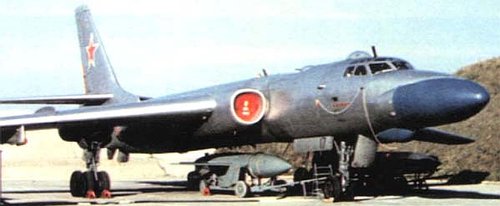
FighterJock
ACCESS: Above Top Secret
- Joined
- 29 October 2007
- Messages
- 5,609
- Reaction score
- 5,938
How many WZ-8 would a converted H-6 bomber carry? One or two? Considering that the converted B-52’s carried two D-21’s on the inner pylons.
- Joined
- 3 June 2011
- Messages
- 18,338
- Reaction score
- 12,240
How many WZ-8 would a converted H-6 bomber carry? One or two? Considering that the converted B-52’s carried two D-21’s on the inner pylons.
A B-52 is a damn sight bigger than an H-6. From the looks of it, one on the centerline. (At least they've been showing a semi-conformal fuselage slot, presumably for a WZ-8 or other munition.)
That said, they could carry a pair of 9,000lb AS-5 Kelts back in the day.
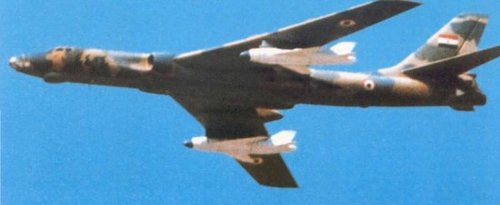
FighterJock
ACCESS: Above Top Secret
- Joined
- 29 October 2007
- Messages
- 5,609
- Reaction score
- 5,938
How heavy is the WZ-8? are they heavier than the Kelt cruise missile?
Kind of sort of related if you squint your eyes.

 www.thedrive.com
www.thedrive.com

China Reveals Wind Tunnel Tests Of Space Plane-Launching High-Speed Mothership Aircraft
Such a system would give China the ability to rapidly and unpredictably access space with a reusable orbiter.
kaiserd
I really should change my personal text
- Joined
- 25 October 2013
- Messages
- 1,657
- Reaction score
- 1,726
That’s adorable
Well maybe not that adorable....
Probably something tailored for Taiwan overflight. Not much range.
Could it be a one-way ride to a US carrier and therefore longer ranged and actually be a maneuvering high speed weapon? Serious question
- Joined
- 3 June 2011
- Messages
- 18,338
- Reaction score
- 12,240
Yes, boost/glide I guess.
Vought's Regulus was however not a rocket plane
You have a landing weight at the end of the mission that is basically that of an empty shell, a small fraction only of what it was at mission launch (think glider and soaring planes) .
That is why I am surprised to see a fully designed undercarriage.
Vought's Regulus was however not a rocket plane
You have a landing weight at the end of the mission that is basically that of an empty shell, a small fraction only of what it was at mission launch (think glider and soaring planes) .
That is why I am surprised to see a fully designed undercarriage.
Last edited:
- Joined
- 3 June 2011
- Messages
- 18,338
- Reaction score
- 12,240
Vought's Regulus was not a rocket plane
No, it was a missile. Pointing out that early test vehicles could have landing gear even if the production model might not. Does make me wonder how much range the thing could possibly have being rocket powered and expected to land. Come to think of it, a likely scenario might be the H-6 ranging way out over the Pacific, the missile flying to a REALLY high altitude, and gliding to one of their new "islands" soaking up RF all the way along. From 120,000 feet you could cover a swath 850 miles wide. From 150,000ft about 950 miles.
Last edited:
- Joined
- 3 June 2011
- Messages
- 18,338
- Reaction score
- 12,240
Regarding mission profile, I have more in mind something Eastward (launched over the Pacific toward China with Taiwan on the way) .
I was thinking maybe they'd use it to try to spot CVBGs for targeting their antiship ballistic missiles.
- Joined
- 27 December 2005
- Messages
- 17,748
- Reaction score
- 26,422
Attachments
siegecrossbow
I really should change my personal text
- Joined
- 12 March 2012
- Messages
- 707
- Reaction score
- 2,106
That looks like a flight capable aircraft to me. I am partly surprised that the carry lugs are not spring loaded and able to rotate to create a flush surface. I suppose the flow there will be turbulent anyway so not worth the effort. Looks like a high and fast recon UAV. Question is, could the H-8 get out past the target to fire the UAV back towards the landing site in the case of Taiwan. Seems less of an issue in the SCS where it may well be able to get from one side to the other.
From the look of that open upper access panel, I would suggest it has parachute braking. I imagine its pretty fast on landing so long runway or good decceleration capabilities.
Recovery is optional. If you can get it back, good, but if you can't then losing it is not too big of a deal.
- Joined
- 27 December 2005
- Messages
- 17,748
- Reaction score
- 26,422
There's more shots of it posted online. It certainly isn't stealthy in detailed design.
In_A_Dream
ACCESS: Top Secret
- Joined
- 3 June 2019
- Messages
- 672
- Reaction score
- 686
There's more shots of it posted online. It certainly isn't stealthy in detailed design.
What do you believe its purpose is? It's kind of hard to tell.
- Joined
- 3 June 2011
- Messages
- 18,338
- Reaction score
- 12,240
Probably rapid response recon. Maybe even something like a "loyal wingman" situation.There's more shots of it posted online. It certainly isn't stealthy in detailed design.
What do you believe its purpose is? It's kind of hard to tell.
- Joined
- 27 December 2005
- Messages
- 17,748
- Reaction score
- 26,422
Attachments
- Joined
- 27 December 2005
- Messages
- 17,748
- Reaction score
- 26,422
Probably rapid response recon. Maybe even something like a "loyal wingman" situation.There's more shots of it posted online. It certainly isn't stealthy in detailed design.
What do you believe its purpose is? It's kind of hard to tell.
Rapid response recon isn't that rapid if you have to wait for the H-6 to lift it to altitude and near to target. I'm pretty sure you could fly it Mach 4, above 70,000ft over a certain island of interest and it would be a rather challenging intercept, but what makes it better than satellites for this purpose? Presumably as satellites have predictable paths, this is useful to surprise an adversary and catch him off-guard. Not to mention the soft power of being able to fly with impunity over another country.
Last edited:
- Joined
- 3 June 2011
- Messages
- 18,338
- Reaction score
- 12,240
Depends. Maybe you could get it over the area in question quicker than the next satellite pass. Also, it would be less predictable than a satellite. (As you point out.)Probably rapid response recon. Maybe even something like a "loyal wingman" situation.There's more shots of it posted online. It certainly isn't stealthy in detailed design.
What do you believe its purpose is? It's kind of hard to tell.
Rapid response recon isn't that rapid if you have to wait for the H-6 to lift it to altitude and near to target. I'm pretty sure you could fly it Mach 4, above 70,000ft over a certain island of interest and it would be a rather challenging intercept, but what makes it better than satellites for this purpose? Presumably as satellites have predictable paths, this is useful to surprise an adversary and catch him off-guard. Not to mention the soft power of being able to fly with impunity over another country.
_Del_
I really should change my personal text... Or not.
- Joined
- 4 January 2012
- Messages
- 1,315
- Reaction score
- 1,812
It'd probably be pretty good as a ferret, because an inbound return coming at high speed is going to get a lot of attention, giving you a glimpse of all those frequencies you are interested. Wouldn't want to have to buy insurance on them, though.
As someone noted above, if you had two of them (cut your latest CEP in thirds, and toss a flight on either side), you could probably make a rather large circle much smaller at the likely cost of two UAVs.
As someone noted above, if you had two of them (cut your latest CEP in thirds, and toss a flight on either side), you could probably make a rather large circle much smaller at the likely cost of two UAVs.
hmm the closer you look the worse the quality gets.
Not sure I agree. Have you ever seen an SR-71 or a Space Shuttle up close? I got to see the Discovery while it was stacked up in the VAB. Thing looked like *garbage.* The average SR-71 looks almost like a film prop up close. You expect pristine, smooth, flawless... you get dents and wrinkles and rivets and dirt.
antigravite
ACCESS: Top Secret
- Joined
- 25 April 2008
- Messages
- 836
- Reaction score
- 258
Hi. Given its very shape, WZ-8 has always been designed as a potential hypersonic platform. Even maybe from day one. This recent news should come as no surprise, really. Today, as we are shown or rather showcased this asset fitted with a liquid rocket engine propulsion system, it would not be surprising for this platform to alternate powered / unpowered phases whilst performing a typical recee or BDA mission profile. This scenarios is occasionnaly referede to as pulsed propulsion. It would save fuel and increase signature management ("stealth") during the unpowered gliding phase. FWIW, 15 years ago or so, I read an AIAA technical paper which might have been older, describing the pros and cons of any such mission scenario, i.e. pulsed propulsion vs continuous propulsion mode to increase measurable performances such as range. To make things clear, what I am not referering to here, is anything like PDE (pulsed detonation engines) and the likes. The paper I am referering to, might have been published in the Journal of Propulsion and Power, but this is so old and I came across this only once, so I memory may not reecall this picture perfectly. Well… any interested party should do their homework.
A.
A.
- Joined
- 27 December 2005
- Messages
- 17,748
- Reaction score
- 26,422
It appears to be a real item not a mockup.I like how people are discussing surface finish of an airframe they don't even know if being flyworthy or mockup AGAIN.
Thing is, a mockup would look *better.* If this is a mockup, they went to a lot more effort than is normally gone to for such things. It's entirely possible that this is just a model, but it's one that the ChiComs went to unusual lengths to make look realistic.I like how people are discussing surface finish of an airframe they don't even know if being flyworthy or mockup AGAIN.

